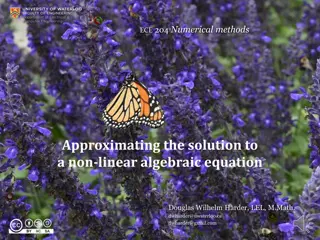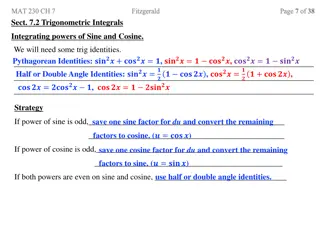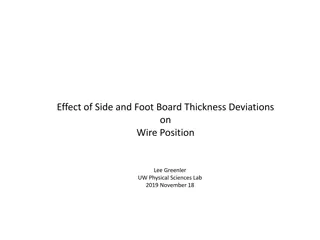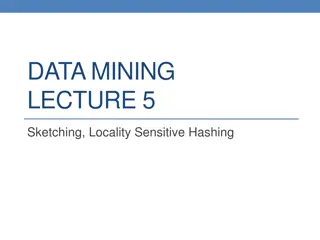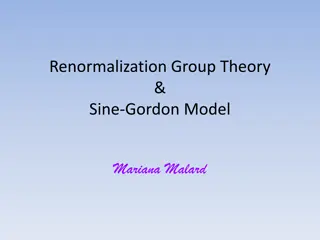Canted Cosine Theta with HTS Superconductors
This project delves into innovative superconducting magnets, particularly CCT in HTS, aiming to form strategic partnerships for HTS magnet technology in accelerators. Tasks include coordination, engineering designs, and construction of demonstrator magnets. The project also focuses on the conceptual
0 views • 16 slides
AnglE: An Optimization Technique for LLMs by Bishwadeep Sikder
The AnglE model introduces angle optimization to address common challenges like vanishing gradients and underutilization of supervised negatives in Large Language Models (LLMs). By enhancing the gradient and optimization processes, this novel approach improves text embedding learning effectiveness.
9 views • 33 slides
Solving right triangles
Discover how to solve right triangles using trigonometric ratios and angle measures. Explore examples and real-world applications, such as calculating street grades in San Francisco. Learn how to identify angles using sine, cosine, and tangent ratios, and use inverse trigonometric functions to find
0 views • 26 slides
Coordinates on the Unit Circle
Exploring how the coordinates on the unit circle correspond to trigonometric functions like sine, cosine, and tangent. Learn how to find these values for angles on the unit circle and how to apply trigonometry principles when points are not on the unit circle.
9 views • 6 slides
Approaches for Approximating Non-Linear Equations
Techniques for approximating solutions to non-linear algebraic equations involve converting the problem into a root-finding one. Seven methods such as Newton's method, bisection method, and linear interpolation are utilized with specific halting conditions. Tangent and secant lines, as well as Taylo
4 views • 13 slides
Basic Trigonometry Concepts
Trigonometry is the study of triangles and the relationship between their sides and angles, particularly in right triangles. This introduction covers the basic trigonometric functions such as sine, cosine, and tangent, explaining their ratios in relation to angles and sides. By understanding these f
0 views • 16 slides
Trigonometric Integrals: Strategies and Identities
Learn useful trigonometric identities and strategies for integrating powers of sine and cosine. Understand when to use Pythagorean, Half or Double Angle Identities, and how to handle odd or even powers efficiently. Examples provided for clarity.
1 views • 14 slides
Calculus Examples and Practice
Explore various calculus problems involving finding gradients, equations of tangents and normals, and analyzing curves. Practice determining gradients at specific points, solving for coordinates, and differentiating equations to find tangent and normal lines. Understand the relationship between grad
1 views • 11 slides
Trigonometric Problems: Mixed, Sine and Cosine Rules
This strand delves into trigonometric problems focusing on triangles with mixed information, exploring side lengths and angle measurements beyond right-angled triangles. It covers mixed problems, sine and cosine rules, applying area of any triangle, and Heron's formula. Engage in various exercises i
2 views • 28 slides
Trigonometry: Identities, Equations, and Problem Solving Techniques
Explore various trigonometric identities, solve trigonometry equations, and learn problem-solving techniques in trigonometry. Discover how to use basic trigonometry to find missing sides, understand trigonometric identities, and tackle challenging trigonometry problems involving sine, cosine, and ta
1 views • 17 slides
Trigonometric Ratios and Examples
Trigonometry involves studying the relationships between the angles and sides of triangles. This content covers trigonometric ratios in right-angled triangles, including sine, cosine, tangent, secant, cosecant, and cotangent. It provides examples and illustrations to help understand how to apply the
1 views • 20 slides
Trigonometric Ratios and Functions in Algebra 2
This chapter in Algebra 2 focuses on trigonometric ratios and functions related to right triangles. It covers concepts such as sine, cosine, tangent, cotangent, secant, and cosecant functions. The content explains how to evaluate these functions for angles in right triangles, special right triangles
0 views • 37 slides
Alternating Current and Voltage Waveforms
Alternating current and voltage exhibit specific waveform patterns such as sinusoidal waves. The sinusoidal waveform, including sine waves and harmonics, is fundamental in AC circuits. Sources like alternators produce sinusoidal voltages, while electronic signal generators create various waveforms f
0 views • 70 slides
Trigonometric Ratios in Right Triangles
Learn about trigonometric ratios like sine, cosine, and tangent in right triangles, and how to find side lengths and solve real-world problems using these ratios. Understand the AA Similarity Postulate and how to write trigonometric ratios as fractions and decimals. Dive into examples and exercises
0 views • 49 slides
Comparing Bike Pedal Motion to Sine Function Graph
When riding a bike and pumping the pedals at a constant rate, the graph of the height of one foot follows a pattern similar to a sine function. Understanding the relationship between the two graphs can help in visualizing trigonometric functions and their translations.
0 views • 9 slides
Introduction to Quantum Mechanics: Energy Levels and Schrödinger Equation
Quantum mechanics reveals that all systems possess discrete energy levels, determined by solving the Schrödinger equation where the Hamiltonian operator represents total energy. In a particle-in-a-box scenario, potential energy is infinite outside the box. The Schrödinger equation simplifies to a
0 views • 12 slides
Cosine Similarity in Inverted Index for Querying
In this document, Dr. Claudia Pearce explains how to build and query from an inverted index, focusing on calculating the Cosine Similarity. The process involves calculating the dot product of terms in the document and query, updating sums based on term weights, and understanding the significance of
0 views • 15 slides
Renormalization Group Theory & Sine-Gordon Model Lectures
Mariana Malard presents a series of lectures discussing Renormalization Group Theory and the Sine-Gordon model. Starting with a conceptual overview and general procedures, the lectures progress to topics like expressing S in terms of Green's functions, bosonization, and Kosterlitz-Thouless Phase Dia
0 views • 26 slides
Structural Equivalence and Similarity Measures in Network Analysis
This content discusses the concepts of structural equivalence and regular equivalence in network analysis. Structural equivalence is based on shared network neighbors, while regular equivalence considers the similarities of neighboring vertices. Various measures, such as cosine similarity and Pearso
0 views • 12 slides
Impact of Board Thickness Deviations on Wire Displacement
In this study by Lee Greenler at UW Physical Sciences Lab, the effect of side and foot board thickness deviations on wire position was analyzed. The displacement of the wire was found to vary based on the cosine factor, with potential displacements up to ~0.5mm near the pin. Different cases were con
0 views • 5 slides
Sine and Cosine Functions in Graphs
Exploring the unit circle to find values of sine at different angles, understanding periodic functions, and graphing sine and cosine functions with variations in amplitude and periods. Learn about vocabulary related to sin waves, amplitude, and period, and discover how to sketch the graph of y = sin
0 views • 15 slides
Intelligent Information Retrieval: Models, Ranking, and Algorithms
Explore the intricacies of retrieval models, ranking systems, and algorithms in the field of Intelligent Information Retrieval. Learn about the construction of indices, matching and scoring processes, distinguishing between exact-match and best-match retrieval, ranking algorithms like Boolean matchi
0 views • 36 slides
Data Structures in High-Dimensional Space
Explore the concept of clustering data points in high-dimensional spaces with distance measures like Euclidean, Cosine, Jaccard, and edit distance. Discover the challenges of clustering in dimensions beyond 2 and the importance of similarity in grouping objects. Dive into applications such as catalo
0 views • 55 slides
Trigonometry Concepts: Graphs, Symmetry, and Laws Explained
Explore trigonometry concepts such as sine, cosine, and tangent graphs, symmetry in trigonometric functions, and laws of trigonometric functions. Understand how to determine values using symmetry and graph analysis. Practice identifying values in the range 0 to 360 for sine, cosine, and tangent func
1 views • 22 slides
Trigonometric Identities for Double Angles
Special identities like the Pythagorean identity and double angle identities for sine and cosine are explored in this content. The Pythagorean identity states that cosine squared plus sine squared equals one, while the double angle identities provide formulas for cosine of double angles. Through the
0 views • 13 slides
Trigonometric Graphs and Patterns
Explore trigonometric graphs, key features, and transformations. Learn to calculate sine and cosine values, recognize symmetries, and work with acute angles for solving trigonometric problems. Dive into the world of sine, cosine, and tangent functions with visual aids and practice exercises.
0 views • 15 slides
Key and Splines Design at Minia University
Key and splines design play a crucial role in connecting mechanical elements like shafts and hubs to transmit power efficiently. This article covers the types of keys, principles of work, and various classifications of keys such as sunk keys, saddle keys, tangent keys, round keys, and splines. It de
0 views • 20 slides
Text Similarity Techniques in NLP
Explore various text similarity techniques in Natural Language Processing (NLP), including word order, length, synonym, spelling, word importance, and word frequency considerations. Topics covered include bag-of-words representation, vector-based word similarities, TF-IDF weighting scheme, normalize
3 views • 62 slides
The Tangent Ratio in Trigonometry
Explore the concept of the tangent ratio in trigonometry through explicit teaching and visible learning objectives. The content covers identifying hypotenuse, opposite, and adjacent sides in right-angled triangles, understanding the relationship between trigonometric values, and writing tangent rati
0 views • 8 slides
Matrix Functions and Taylor Series in Mathematics
A detailed exploration of functions of matrices, including exponential of a matrix, eigenvector sets, eigenvalues, Jordan-Canonical form, and applications of Taylor series to compute matrix functions like cosine. The content provides a deep dive into spectral mapping, eigenvalues, eigenvectors, and
0 views • 53 slides
Efficient Scoring Techniques in Information Retrieval
Today's focus in Information Retrieval is on efficiently scoring and ranking documents matching a query from an inverted index. The goal is to assign scores to each document and select the top K highest scoring ones. Cutting down CPU usage for scoring while maintaining result quality is essential. T
0 views • 18 slides
Solving for the Radius of the Smallest Circle in Three Circles and a Tangent
Three circles with a common tangent are depicted, and the radii of the larger circles are provided in the diagram. By using geometric properties and calculations, the value of the radius of the smallest circle can be determined accurately.
0 views • 29 slides
Sketching and Locality Sensitive Hashing in Data Mining
Explore the concepts of Jaccard Similarity and Cosine Similarity in data mining, along with their applications in recommendation systems and finding near-duplicates. Discover how Sketching and Locality Sensitive Hashing techniques help in efficiently identifying similar items and solving the Nearest
0 views • 63 slides
Falls and Parkinson's Support Program by Sine Rickard: Enhancing Lives Through Exercise Classes and Group Activities
Falls and Parkinson's Support Program, led by Physiotherapist Sine Rickard, offers exercise classes and group activities for individuals with Parkinson's Disease and Parkinsonism, along with their caregivers. Started in 2003, the program has evolved over the years, providing accessible classes at mu
0 views • 24 slides
Solving Equations Involving Hyperbolas and Parabolas
Utilize substitution to solve equations involving hyperbolas and parabolas that touch at specific points. Discover the values of variables by manipulating equations and identifying intersections between the curves. Utilize the discriminant to solve for double roots and tangent points effectively.
0 views • 9 slides
Utilizing Natural Language Processing for Periodic Developmental Reviews Analysis
This study focuses on evaluating Periodic Developmental Reviews (PDRs) using Natural Language Processing (NLP) to predict cadet ratings and detect copying of responses. With objectives to analyze text statements in PDRs and investigate the prevalence of response duplication, the research aims to pro
0 views • 19 slides
Trigonometry Fundamentals and Functions
Explore the basics of trigonometry with topics ranging from right triangles to inverse trigonometric functions. Learn about trigonometric formulas, solving trigonometric equations, and the values of trigonometric functions like sine, secant, and tangent. Dive into questions about ratios, functions,
0 views • 75 slides
Renormalization Group Theory & Sine-Gordon Model
Get insights into Renormalization Group Theory and the Sine-Gordon Model through lectures covering key concepts such as field theory action, decomposition, Green's functions, model scaling, phase diagrams, symmetries, and phase transitions. Discover how scale invariance and order parameters play a r
0 views • 22 slides
Locus Standi in Legal Litigation
Introduction to the traditional doctrine of locus standi in private law litigation, focusing on the concept of standing to sue and the enforcement of one's legal rights. The article delves into the principles of standing to sue, including the right of a party to appear before a court of law and inst
0 views • 48 slides
Accelerating Local Ensemble Tangent Linear Models
This research focuses on accelerating Local Ensemble Tangent Linear Models with order reduction, exploring methods, results, and implications for advancing numerical modeling in atmospheric and oceanic systems. The study addresses challenges in maintaining accurate TLMs and adjoints for coupled mode
0 views • 21 slides




